In 2022, China's raw milk production is forecast to reach 39.65 million metric tons due to a larger herd and production efficiency gains. China's zero-COVID policy is expected to remain unchanged for the foreseeable future. In 2022, the resurgence of COVID-19 and government restrictions, such as lockdowns, are expected to impact dairy and dairy product distribution and use. Dairy processors are expected to increase whole milk powder production from raw milk to limit losses. In 2022, Post estimates that butter imports will increase compared to 2021, due to demand in the bakery sector. Imported fluid milk (primarily ultrahigh temperature milk) is expected to increase over 2021, due to consumer demand for shelf-stable products. Post estimates that imports of whole milk powder, skim milk powder, and cheese will be lower in 2022. High prices for imported dairy products in 2022 are expected to weigh on growth.
Fluid milk
In 2022, China's raw milk production is expected to reach 39.65 million metric tons (MMT), 4.5 percent higher than 2021 due to a larger dairy herd and improved efficiency. Import growth in 2022 is expected to slow to 1.3 MMT due to higher global prices and competition with domestic production.
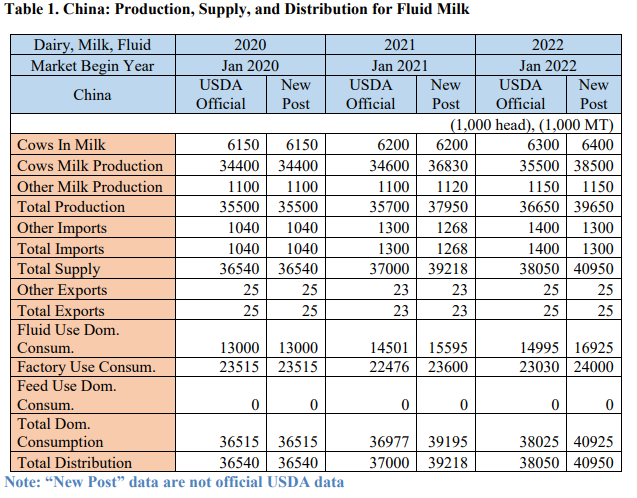
China's 2022 annual agricultural policy document known as the "No. 1 Document" (see GAIN Report CH2022-0029) emphasizes continued development of China's dairy industry. This policy encourages provincial governments to invest in farms, herd expansion, genetic improvements, feed and seed sources, and infrastructure. Provincial regions including Anhui, Jilin, and Inner Mongolia have published initiatives to support these kinds of projects.
In 2022, imports of fluid milk are estimated at 1.3 MMT. Imported fluid milk is typically in the form of ultrahigh temperature (UHT) shelf-stable milk products. Following citywide lockdowns in Shanghai, refrigerated milk products were mostly unavailable. The delivery of products via cold chain logistics also became increasingly difficult. Products such as UHT can be stored at room temperature, without refrigeration and for a longer period than pasteurized milk products. Post anticipates that COVID-19 restrictions will remain for the foreseeable future. For this reason, consumers are likely to gravitate towards products that can be stored, such as UHT milk – ensuring demand for imported fluid milk.
Imports in 2021, totaled 1.268 MMT based on China Customs data. In the first quarter (Q1) of 2022, the average price of imported fluid milk products rose but import volumes remained relatively similar to prior years (see Chart 3).

Germany and New Zealand remain the two largest suppliers of imported fluid milk to China (see Chart 4). In 2022, the General Administration of Customs of China (GACC) announced that under the China-New Zealand free trade agreement (FTA), China would remove special safeguard measures on imports of New Zealand fluid milk, butter, and cheese starting in 2022. Each of these commodities is grouped into a basket and the tariff rates on these goods has declined since the FTA was implemented in 2008.
l Fluid Milk (Basket 1) includes products from the following tariff lines: 04012000, 04014000, and 04015000
l Butter (Basket 3) includes products from the following tariff lines: 04051000 and 04059000
l Cheese (Basket 4) includes products from the following tariff lines: 04061000, 04063000, and 04069000
New Zealand's now tariff free access for fluid milk products is expected to contribute to strong Chinese imports moving forward in comparison to imports from other suppliers.
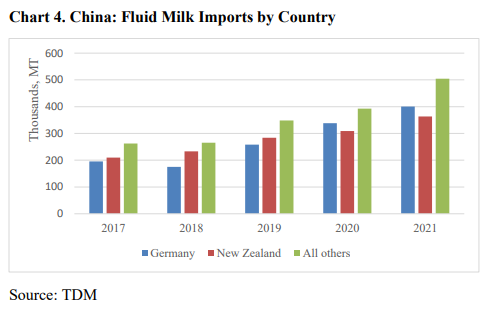
In 2022, GACC published multiple country-specific notifications for dairy product inspection and quarantine requirements. In March 2022, China granted market access to Mongolian dairy products, including fluid milk, cheese, and whey powder, among others. However, many additional steps will be necessary for Mongolian producers to export to China – including GACC facility registration.
Whole Milk Powder (WMP)
In 2022, WMP production is expected to increase slightly to 1.02 MMT as producers convert seasonal surplus raw milk to WMP. In 2022, China instituted strict lockdown measures across many cities due to COVID-19 outbreaks. These measures made distribution and purchases of fluid milk products very difficult causing some dairy processors to increase production of WMP. In 2022, WMP consumption is expected pull from stocks and domestic production. The import estimate for 2022 is reduced to 820 thousand metric tons (TMT) from 849 TMT in 2021.
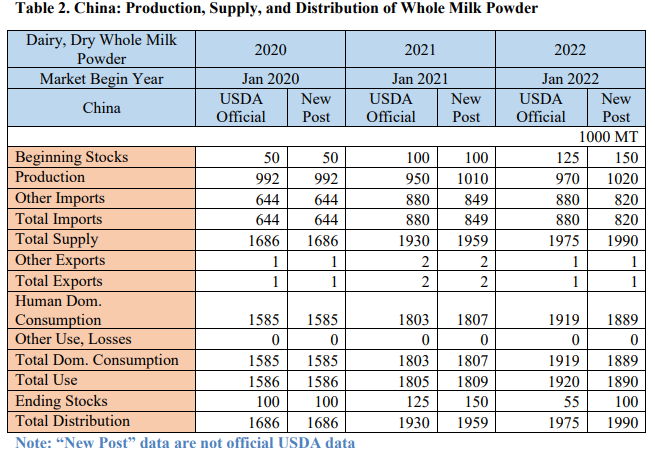
In 2022, WMP imports are estimated at 820 TMT a reduction of 29 TMT from 2021, due to higher import prices, higher beginning stocks, and lower demand. With increased domestic WMP production prices for domestic WMP are expected to decline in 2022 making imported WMP less price competitive. Additionally, the price of imported WMP in Q1 2022 surged 23 percent, on lower global stocks and increased logistics costs. Large purchases of imported WMP at the end of 2021 led to an increase of carryover stocks into 2022. China Customs data for 2021 indicated that imports reached nearly 850 TMT in 2021, nearly 32 percent growth over 2020. These higher stocks are expected to also lower WMP import demand. In 2022, with lower imports and increased consumption, 2022 stocks are expected to move lower to 100 TMT.
In 2022, New Zealand is expected to remain the dominant supplier of WMP. Contacts note that New Zealand WMP is competitively priced, faces lower tariffs, and is considered a benchmark against which other imported WMP products are compared. Imports from Uruguay have also increased. In 2021 and Q1 2022, Uruguay's WMP exports exceeded Australia making Uruguay the second largest exporter of WMP to China. According to media reports, Uruguay is engaging China in free trade agreement conversations, which would likely cover agricultural products.
Skim Milk Powder (SMP)
In 2022, SMP production is expected to reach 24 TMT with imports declining to 400 TMT from 426 TMT in 2021. In China, SMP and WMP are often interchangeable as food ingredients. In 2022, producers are expected to consume less imported SMP due to higher WMP domestic production and stocks, leading to a decline in imports.

Estimated 2022 SMP imports are reduced to 400 TMT, a 6 percent decline from 2021 due to lower market demand. In Q1 2022, the price for imported SMP surged 19 percent, year-on-year, to an 8 year high based on China Customs data. Higher import prices and increase domestic WMP production will lower imports in 2022.
New Zealand, Australia and the United States dominate China's SMP imports accounting for nearly 60 percent of total 2021 imports. In Q1 2022, China's imports of U.S. SMP grew by over 17 percent, driven by competitive import prices and importer confidence in the quality of U.S. SMP.
Cheese
In 2022, imports of cheese products are estimated to decline to 170 TMT from 176 TMT in 2021. China's cheese consumption is driven by hotels, restaurants, and institutions, which have been negatively impacted by COVID-19 restrictions. Higher prices due to increased international logistics costs are another factor contributing to reduced cheese imports in 2022.
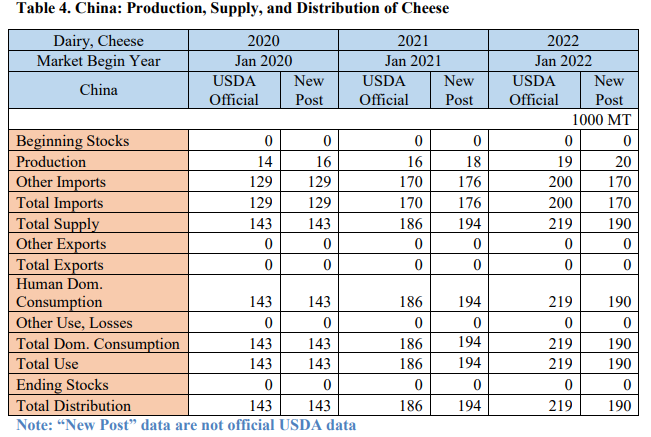
In 2022, the cheese import estimate is reduced to 170 TMT from 176 TMT in 2021. Imports are expected to decline due to COVID-19 lockdowns and logistics disruptions (as mentioned in the fluid milk section and consumption section above). Restrictions have included temporary road closures, testing requirements for truckers and workers, and other measures which at times blocked the movement of goods across provincial and/or local areas in China. For example, in North China companies reported that access to cold storage warehouses containing imported products had been sealed without access to products for over 3 months. In other instances, the positive detection of COVID-19 in staff and/or alleged detection on the outer packaging of products has caused warehouse and/or market closures for extended periods of time. These delays and closures are detrimental for perishable products, such as cheese.
New Zealand, Australia, Denmark, the United States, and Italy are China's top five suppliers of imported cheese. New Zealand accounts for over half of all of China's imports and volumes are expected to continue to grow following the expansion of duty-free access under the China-New Zealand FTA. In the last five years, Demark and Ireland have also seen impressive growth in supplying cheese to China.
China's cheese consumption relies on imported cheese products, as domestic production remains limited. China's imports are based on China Customs data. Import volume of cheese products increased by over 30 percent in 2021 compared to 2020.
Butter
In 2022, butter imports are expected to reach to 150 TMT up from 139 TMT in 2021. Bakeries, an important channel for butter products, are lesser affected by lockdowns than the in-person restaurant sector. Bakeries have continued to operate and deliver products for home consumption, which is expected to grow butter utilization and imports in 2022.
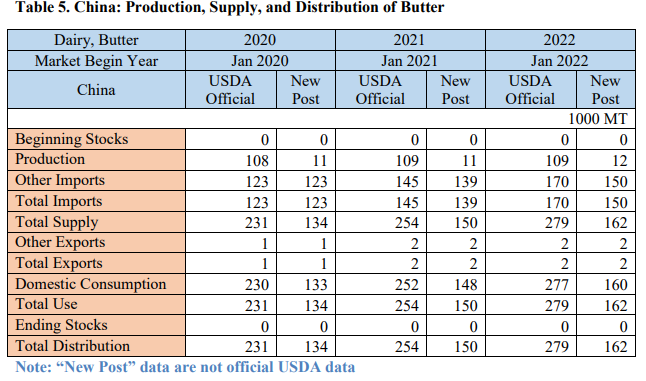
In 2022, butter imports are estimated at 150 TMT, 8 percent higher than in 2021. The rate of growth over previous years is slowing. The supply of butter to bakery and food service sectors relies on imported products. However, higher import prices and continued logistics restrictions may hamper stronger import growth.
New Zealand dominates China's imported butter market and accounts for nearly 80 percent of total imports. The China-New Zealand FTA may further increase New Zealand's dominance as butter imports will be able to enter China duty-free and without special safeguard measures. Other exporting countries, including the United States, have had strong growth in exports often correlated with the price competitiveness of the products.
Whey & Whey Products
The market outlook for whey and whey related products (HS040410, HS350220) has not changed since the 2021 Dairy Annual Report. China Customs data indicates that in 2021, imports of whey and modified whey products (HS040410) saw annual growth of over 15 percent, while HS350220 declined by 10 percent.
Please click the link below to access the report.
static/file/Dairy and Products Semi-annual_Beijing_China - People's Republic of_CH2022-0058.pdf
Source: USDA
Note: This article is compiled by Antion, please indicate our source if reprint it.